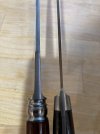screened porch
Basic Member
- Joined
- Feb 19, 2012
- Messages
- 19,332
Horn, I'll bet.What material is the handle ?
The BladeForums.com 2024 Traditional Knife is available! Price is $250 ea (shipped within CONUS).
Order here: https://www.bladeforums.com/help/2024-traditional/
Horn, I'll bet.What material is the handle ?
Haha yeah, I guess these fancier antique knives were more status pieces than anything else, and any duels or self-defense situations requiring their use likely wouldnt've lasted too long anyways. That said, I think the handle is fairly round, so maybe it's not too uncomfortable.I am a bit concerned about the handle and its potential for creating hotspots
It is a very interesting knife.
Likely done for artistic purposes mainly.
What material is the handle ?

One of my favorite Argentinians and one of my favorite Brazillians.
I really like those Brazilian knives two, especially the less "cowboy"-themed ones, even if they were mass-produced. I see no "inox" mark, so I take it it's is carbon steel, right?One of my favorite Argentinians and one of my favorite Brazillians.

There's a tiny inox under the tiny twisted bugle.I see no "inox" mark, so I take it it's is carbon steel, right?

Nice! I personally don't care either whether it's stainless steel or not -- in fact the one I ordered is stainless too. I was asking more from a dating standpoint. In any case, from what I've seen some of these stainless Brazilian knives were made pretty early -- as early as the 50s, and maybe earlier.There's a tiny inox under the tiny twisted bugle.

They're good, hard steel, mass-produced thought they be.

I really like the etching on the bottom one.I think these are an interesting pair, being almost the same size but not.

The cowboy one is the first one I bought, for $30 from the practical widow of the guy who'd had it marked $130 years before.
The slim one has some gold wash surviving above the belt hook.





Very nice, Christian. Are you using it often for food prep? Looks like it would make a great chef's knife.I didn't take pictures the first time I used my puñal, but I remembered to do so this time.
View attachment 2262088
Beautiful pics. Do you have any?So, how do you guys feel about clip-point gaucho knives? I know they are by no means the norm, but they did exist, even back in the day, and they seem to have been most common in Brazil:





As a big bowie knife enthusiast, I like them quite a bit, and have been wanting to make myself one using an old chef's knife blade.
I do not, yet, but I already started working on one:Beautiful pics. Do you have any?

If I ever finish turning my Sabatier into a punal, I won't be showing it here!I do not, yet, but I already started working on one:

A Sabatier blade could make for a very handsome gaucho knife, IMO. The issue with Sabatiers (in the narrow sense, i.e., in the French style) is that they tend to be pretty thin. I'd suggest keeping an eye for used German-style chef's knives, as some (especially older models) have fairly thick blades.If I ever finish turning my Sabatier into a punal, I won't be showing it here!
I've gotten as far as sawing off the pinkie-hook. Then I thought, nobody's going to believe my handle workmanship came from Patagonia. Just make a sheath!
Or better yet, find one.


Nice. That's a lot of work, taking down the fat heel brace. Beautiful work with the sterling handle, too.A Sabatier blade could make for a very handsome gaucho knife, IMO. The issue with Sabatiers (in the narrow sense, i.e., in the French style) is that they tend to be pretty thin. I'd suggest keeping an eye for used German-style chef's knives, as some (especially older models) have fairly thick blades.
In the last few months (basically since I found this thread), I've been working on several gaucho-style projects with German blades in my free time. Here's one that I did with a Hoffritz blade from the 80s (stainless, 8" long, 4.5mm thick) and the handle of an older Webster bread knife (sterling):

I still need to polish the handle, glue it to the blade, hand-sand the latter, and make a sheath, but you get the idea. Here's how it looked before:


I'm using it for some food prep, but my puñal will get smoked by a proper chef's knife. The blade is just too thick compared to an optimized kitchen knife, using it would get fatiguing too quickly.Very nice, Christian. Are you using it often for food prep? Looks like it would make a great chef's knife.

